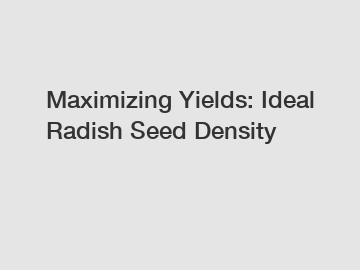Maximizing Yields: Ideal Radish Seed Density
Maximizing Yields: Ideal Radish Seed Density.
Radishes are an important and widely grown vegetable crop, known for their quick growth and crisp, peppery flavor. As a result, growers are constantly seeking ways to maximize their yields and ensure a successful harvest. One crucial factor that significantly affects radish yield is the seed density when sowing. In this article, we will discuss the importance of ideal radish seed density, its origins, how it is justified, and the implications and impact it has on crop productivity.
Origin of Ideal Radish Seed Density:

The concept of ideal radish seed density stems from the principle of overcrowding prevention during germination and early growth stages. Overcrowding can result in competition for resources such as water, nutrients, and sunlight, leading to stunted growth and reduced yields. Moreover, excessive density can create a favorable environment for pests and diseases, further hampering the crop's growth.
Justification of Ideal Radish Seed Density:
To determine the ideal radish seed density, several factors need to be considered. Firstly, the size of radish seeds plays a crucial role. Smaller seeds typically necessitate higher densities to achieve a uniform stand, as they occupy less space in the soil. Conversely, larger seeds require lower densities to ensure sufficient room for each seed to develop without hindrance.
Additionally, the desired marketable radish size influences seed density. If smaller radishes are preferred, a higher seed density is necessary to produce a more abundant crop. Conversely, larger radishes can be achieved with lower densities, allowing seeds to develop more fully.
Another important factor is the type of radish being grown. Different varieties have differing growth habits and root sizes, which directly influence seed density. For instance, smaller varieties may require higher densities to achieve optimal growth, while larger varieties may thrive with lower densities.
Implications and Impact:
Achieving the ideal radish seed density has several implications and impacts on crop productivity. Firstly, it promotes uniform and consistent germination, leading to an even stand and preventing competition between seedlings. This ensures that each plant has access to sufficient resources for healthy growth, maximizing yield potential.
Moreover, maintaining the ideal seed density allows for easier weed management. A well-spaced crop makes it simpler to identify and remove weeds, reducing competition and preventing potential yield losses.
Furthermore, appropriate seed density contributes to disease and pest control. Proper spacing encourages better airflow and sunlight penetration, reducing moisture on the foliage and minimizing the risk of fungal diseases. Adequate spacing also hampers the spread of pests, limiting their ability to attack multiple plants in close proximity.
In conclusion, ideal radish seed density is a crucial aspect of maximizing yields. By preventing overcrowding, growers can ensure each plant has adequate access to resources, promoting uniform growth and healthy development. The determination of ideal seed density depends on various factors, including seed size, desired radish size, and radish variety. Ultimately, maintaining the optimal seed density has significant implications for weed control, disease prevention, and overall crop productivity.
Contact us to discuss your requirements of china ventura celery, medium fruit watermelon seeds manufacturer, 8424 watermelon manufacturer. Our experienced sales team can help you identify the options that best suit your needs.

Comments